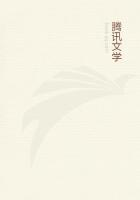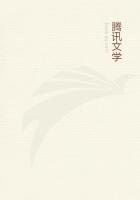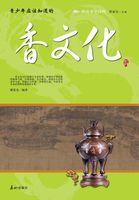THE TAVERN
The gate of Blangy, built by Bouret, was formed of two wide pilasters of projecting rough-hewn stone; each surmounted by a dog sitting on his haunches and holding an escutcheon between his fore paws.The proximity of a small house where the steward lived dispensed with the necessity for a lodge.Between the two pilasters, a sumptuous iron gate, like those made in Buffon's time for the Jardin des Plantes, opened on a short paved way which led to the country road (formerly kept in order by Les Aigues and the Soulanges family) which unites Conches, Cerneux, Blangy, and Soulanges to Ville-aux-Fayes, like a wreath, for the whole road is lined with flowering hedges and little houses covered with roses and honey-suckle and other climbing plants.
There, along a pretty wall which extends as far as a terrace from which the land of Les Aigues falls rapidly to the valley till it meets that of Soulanges, are the rotten posts, the old wheel, and the forked stakes which constituted the manufactory of the village rope-maker.
Soon after midday, while Blondet was seating himself at table opposite the Abbe Brossette and receiving the tender expostulations of the countess, Pere Fourchon and Mouche arrived at this establishment.From that vantage-ground Pere Fourchon, under pretence of rope-making, could watch Les Aigues and see every one who went in and out.Nothing escaped him, the opening of the blinds, tete-a-tete loiterings, or the least little incidents of country life, were spied upon by the old fellow, who had set up this business within the last three years,--a trifling circumstance which neither the masters, nor the servants, nor the keepers of Les Aigues had as yet remarked upon.
"Go round to the house by the gate of the Avonne while I put away the tackle," said Pere Fourchon to his attendant, "and when you have blabbed about the thing, they'll no doubt send after me to the Grand-
I-Vert, where I am going for a drop of drink,--for it makes one thirsty enough to wade in the water that way.If you do just as I tell you, you'll hook a good breakfast out of them; try to meet the countess, and give a slap at me, and that will put it into her head to come and preach morality or something! There's lots of good wine to get out of it."
After these last instructions, which the sly look in Mouche's face rendered quite superfluous, the old peasant, hugging the otter under his arm, disappeared along the country road.
Half-way between the gate and the village there stood, at the time when Emile Blondet stayed at Les Aigues, one of those houses which are never seen but in parts of France where stone is scarce.Bits of bricks picked up anywhere, cobblestones set like diamonds in the clay mud, formed very solid walls, though worn in places; the roof was supported by stout branches and covered with rushes and straw, while the clumsy shutters and the broken door--in short, everything about the cottage was the product of lucky finds, or of gifts obtained by begging.
The peasant has an instinct for his habitation like that of an animal for its nest or its burrow, and this instinct was very marked in all the arrangements of this cottage.In the first place, the door and the window looked to the north.The house, placed on a little rise in the stoniest angle of a vineyard, was certainly healthful.It was reached by three steps, carefully made with stakes and planks filled in with broken stone and gravel, so that the water ran off rapidly; and as the rain seldom comes from the northward in Burgundy, no dampness could rot the foundations, slight as they were.Below the steps and along the path ran a rustic paling, hidden beneath a hedge of hawthorn and sweet-brier.An arbor, with a few clumsy tables and wooden benches, filled the space between the cottage and the road, and invited the passers-by to rest themselves.At the upper end of the bank by the house roses grew, and wall-flowers, violets, and other flowers that cost nothing.Jessamine and honey-suckle had fastened their tendrils on the roof, mossy already, though the building was far from old.
To the right of the house, the owner had built a stable for two cows.
In front of this erection of old boards, a sunken piece of ground served as a yard where, in a corner, was a huge manure-heap.On the other side of the house and the arbor stood a thatched shed, supported on trunks of trees, under which the various outdoor properties of the peasantry were put away,--the utensils of the vine-dressers, their empty casks, logs of wood piled about a mound which contained the oven, the mouth of which opened, as was usual in the houses of the peasantry, under the mantle-piece of the chimney in the kitchen.
About an acre of land adjoined the house, inclosed by an evergreen hedge and planted with grape-vines; tended as peasants tend them,--
that is to say, well-manured, and dug round, and layered so that they usually set their fruit before the vines of the large proprietors in a circuit of ten miles round.A few trees, almond, plum, and apricot, showed their slim heads here and there in this enclosure.Between the rows of vines potatoes and beans were planted.In addition to all this, on the side towards the village and beyond the yard was a bit of damp low ground, favorable for the growth of cabbages and onions (favorite vegetables of the working-classes), which was closed by a wooden gate, through which the cows were driven, trampling the path into mud and covering it with dung.
The house, which had two rooms on the ground-floor, opened upon the vineyard.On this side an outer stairway, roofed with thatch and resting against the wall of the house, led up to the garret, which was lighted by one round window.Under this rustic stairway opened a cellar built of Burgundy brick, containing several casks of wine.

